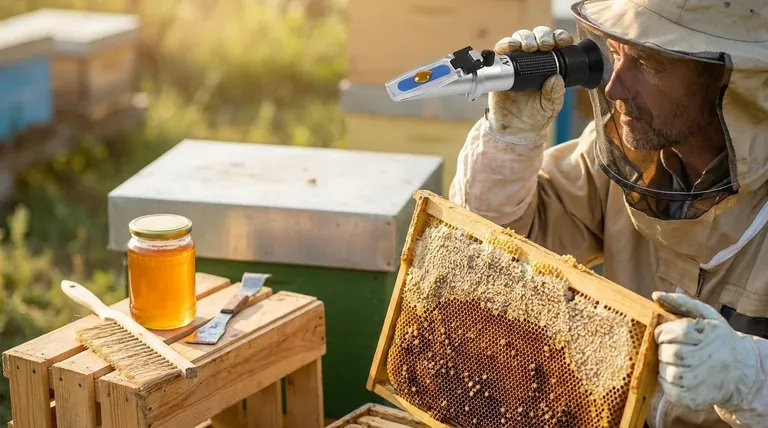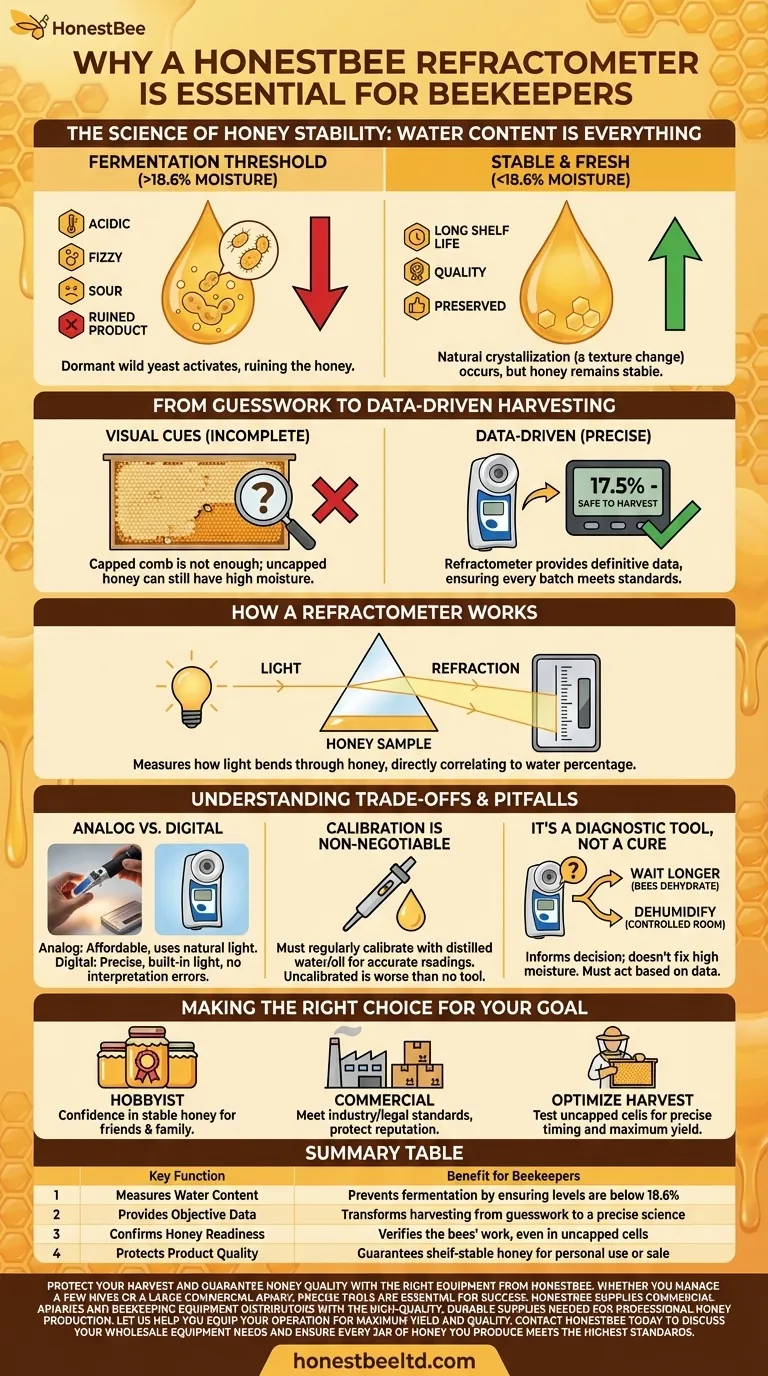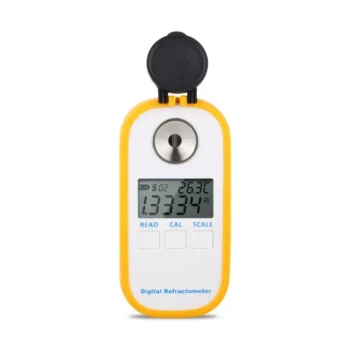A honey refractometer is a beekeeper's primary tool for quality assurance. It is an essential instrument used to measure the precise water content in honey. This single measurement is critical because it allows a beekeeper to predict whether their harvested honey will remain stable and fresh in the jar or if it is at risk of fermenting and spoiling.
The core difference between high-quality, shelf-stable honey and a spoiled, fermented batch is its moisture level. A refractometer is the only tool that provides this objective data, transforming your harvesting decisions from guesswork into a precise, data-driven science.

The Science of Honey Stability: Water Content is Everything
Honey is a supersaturated sugar solution, and its longevity depends almost entirely on maintaining a low water content. A refractometer gives you the exact data you need to assess this crucial factor.
The Fermentation Threshold
Honey with a water content above approximately 18.6% contains enough moisture to activate dormant wild yeast cells. This begins the process of fermentation, turning the honey acidic, fizzy, and sour, ultimately ruining the product.
The Crystallization Factor
Conversely, honey with a very low water content is more likely to crystallize. This is a natural process where glucose separates from the solution. While crystallization changes the texture, the honey remains perfectly stable and unspoiled.
Confirming the Bees' Work
Bees instinctively know when honey is ready. They reduce its moisture content by fanning their wings over the nectar before sealing it in a cell with a wax capping. A refractometer scientifically confirms that this dehydration process is complete, even in uncapped cells you might be tempted to harvest.
From Guesswork to Data-Driven Harvesting
Relying solely on visual cues like capped comb is an incomplete strategy. A refractometer provides definitive data that ensures every batch meets quality standards.
The Problem with Visual Cues
A frame might be 80% capped, but the remaining uncapped honey could have a high moisture content due to recent nectar flow or high ambient humidity. Harvesting it can compromise the entire batch.
How a Refractometer Provides an Answer
This simple device works by measuring how light bends, or refracts, as it passes through a thin sample of honey. The angle of refraction directly correlates to the percentage of water in the honey, giving you an immediate and precise reading.
Getting a Precise, Actionable Number
Instead of guessing, you get a clear number. If the reading is 17.5%, you know the honey is safe to harvest and bottle. If it reads 20%, you know you must wait for the bees to dehydrate it further.
Understanding the Trade-offs and Common Pitfalls
While essential, a refractometer's value depends on its proper use and understanding its limitations.
Analog vs. Digital Models
Analog refractometers are affordable and work by holding the device up to a natural light source to read a scale. Digital models are more expensive but use a built-in light source and provide an exact number on a screen, eliminating user interpretation and issues with low light.
Calibration is Non-Negotiable
An uncalibrated refractometer is worse than no tool at all because it provides false data. You must regularly calibrate your device, typically with distilled water or a special calibration oil, to ensure its readings are accurate.
It's a Diagnostic Tool, Not a Cure
A refractometer tells you if the moisture content is too high; it does not fix the problem. The data it provides informs your decision to either wait longer before harvesting or to place frames in a dehumidified room to help reduce moisture before extraction.
Making the Right Choice for Your Goal
Using a refractometer correctly is about protecting your hard work and guaranteeing a quality product, whether for your pantry or for sale.
- If you are a hobbyist beekeeper: A refractometer provides the confidence that the honey you bottle for friends and family is stable and will not ferment over time.
- If you are a commercial beekeeper: This tool is non-negotiable for meeting industry and legal standards (often below 18.6% moisture), protecting your product's quality and your business's reputation.
- If your goal is to optimize harvest timing: Use the refractometer to test honey from uncapped cells, allowing you to know exactly when the maximum amount of honey is ready, rather than waiting for every cell to be capped.
Ultimately, a refractometer empowers you to guarantee the quality and longevity of every single jar of honey you produce.
Summary Table:
| Key Function | Benefit for Beekeepers |
|---|---|
| Measures Water Content | Prevents fermentation by ensuring levels are below 18.6% |
| Provides Objective Data | Transforms harvesting from guesswork to a precise science |
| Confirms Honey Readiness | Verifies the bees' work, even in uncapped cells |
| Protects Product Quality | Guarantees shelf-stable honey for personal use or sale |
Protect your harvest and guarantee honey quality with the right equipment from HONESTBEE.
Whether you manage a few hives or a large commercial apiary, precise tools are essential for success. A reliable honey refractometer is a fundamental part of any beekeeper's toolkit, providing the critical data needed to prevent spoilage and ensure customer satisfaction.
HONESTBEE supplies commercial apiaries and beekeeping equipment distributors with the high-quality, durable supplies needed for professional honey production. Let us help you equip your operation for maximum yield and quality.
Contact HONESTBEE today to discuss your wholesale equipment needs and ensure every jar of honey you produce meets the highest standards.
Visual Guide

Related Products
- Precision Honey Refractometer Instrument for Quality Assessment
- Digital Honey Refractometer for Precision Measurement of Optimal Honey Quality
- Professional Thermostatic Conical Honey Melter
- Honey Concentrating Vacuum Heating Thickening Machine Dehumidifier for Honey
- HONESTBEE 3-Frame Manual Acrylic Honey Extractor
People Also Ask
- What are the key points for proper usage of a honey refractometer? Ensure Accurate Moisture Readings Every Time
- What are the benefits of using a Pocket Digital Honey Refractometer? Achieve Precision & Speed in Honey Quality Control
- What are the key steps to using a honey refractometer? Ensure Honey Quality & Prevent Fermentation
- Why is a honey refractometer essential for honey harvesting? Protect Your Harvest from Spoilage
- What are the features of the Standard Refractometer for honey moisture content? Essential Tools for Quality Control



















